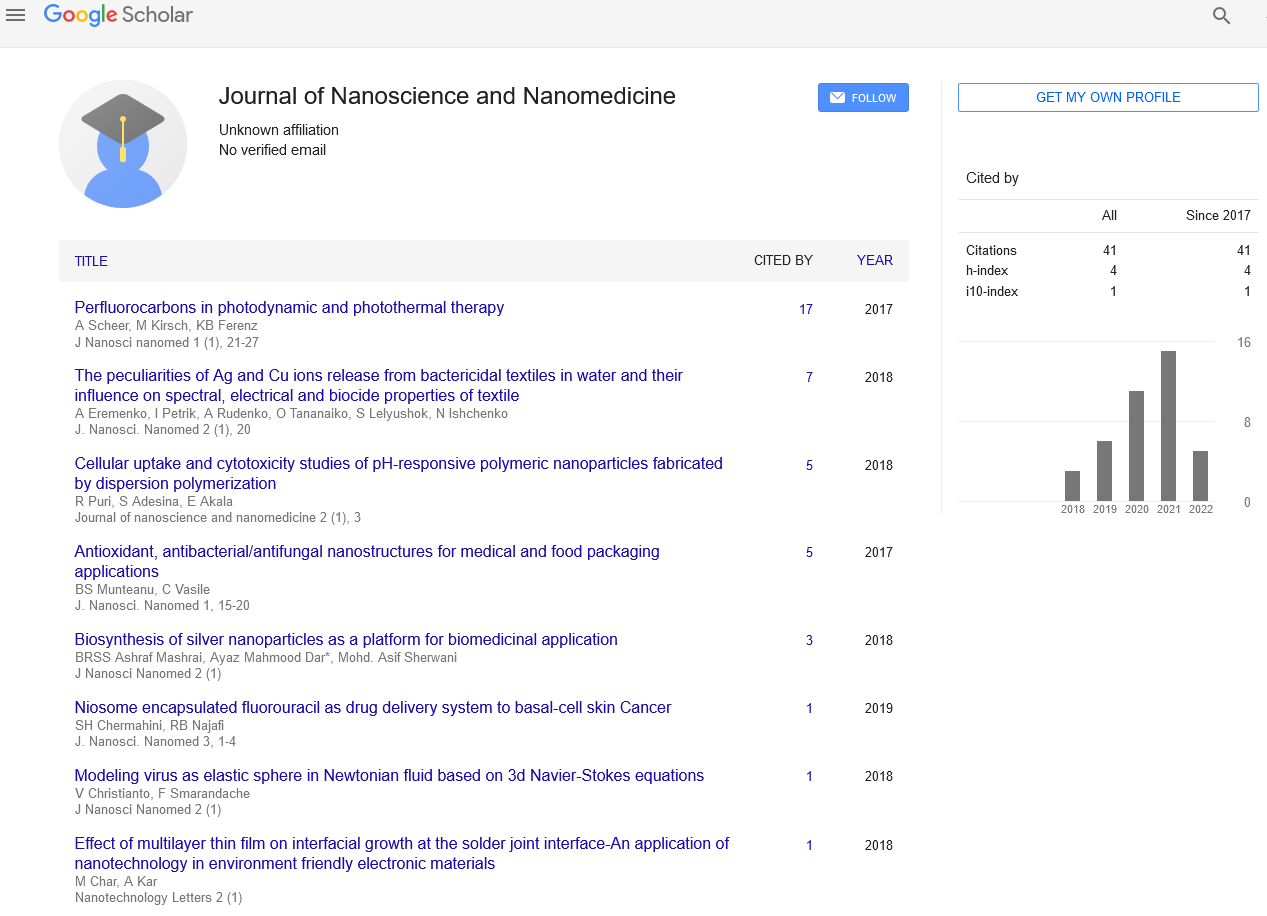Nanoparticle Therapy: In Curing Alzheimer Disease?
Received: 03-Jan-2021 Accepted Date: Jan 16, 2020; Published: 30-Jan-2021
Citation: Perzynski B. Nanoparticle Therapy: In Curing Alzheimer Disease. J Nanosci Nanomed 2021;5(1):5.
This open-access article is distributed under the terms of the Creative Commons Attribution Non-Commercial License (CC BY-NC) (http://creativecommons.org/licenses/by-nc/4.0/), which permits reuse, distribution and reproduction of the article, provided that the original work is properly cited and the reuse is restricted to noncommercial purposes. For commercial reuse, contact reprints@pulsus.com
Abstract
Treatment of brain infections is continuously restricted by the physiological nature of the exceedingly specific blood-brain boundary (BBB) and the electrostatic charge of the nano porous extracellular lattice. Nanomedical application gives a promising medicate conveyance insurgency for the treatment of neurodegenerative illnesses (NDDs). It depends on making strides the pharmacokinetic dissemination of drugs through the central anxious framework. Neurotrophic variables when coordinates with the nanotechnological approaches can pass the BBB simply, speaking to a critical challenging track. The display paper points to survey, layout, and summarize different endeavours wiped out the field of utilizing nanoparticles within the administration of Alzheimer.
Introduction
Neurodegenerative illnesses (NDDs) are weakening disarranges that essentially influence the neuron cells, and they worsen the brain and central apprehensive framework (CNS) continuously which seriously aggravate the engine and cognitive capacities which may conclusion with either total incapacities or passing. Indications of NDDs frequently advance gradually over the long time [1]. The coming about brief- or long-term disabilities and impediments may burden the quality of life of patients, families, and social systems [2, 3]. Nanoparticle frameworks can be utilized with a few courses of organization such as verbal, nasal, and parenteral counting intravenous, intramuscular, subcutaneous, and intraocular. The lion's share of the nanoparticle frameworks that are utilized are composed of both characteristic and manufactured polymers, proteins, and polysaccharides in which the sedate is consolidated for focused on brain conveyance.
Blood-brain boundaries challenge the sedate conveyance plan. In common, pharmaceutical sedate measurement shapes cannot effectively cross the BBB; in any case, they can pass as it were by dynamic efflux or carrier-mediated transport within the normal medicate definitions with exceptionally small bioavailability. In vivo and in vitro ponders confirmed the entry of nanoparticles through the BBB. They bolstered the consolidation of the nanotherapeutic substances into the brain, so nanoparticles can moreover be connected in conclusion as well as brain-targeted treatment and quality treatment [4].
Nanoparticles in Treatment of Neurodegenerative Diseases and nanotechnology in biomedicine and the hopeful developing of analysts and applications within the areas of nanomedicine and neuroscience give the researchers with a promising trust for the examination and administration of NDDs. The applications incorporate focused on sedate conveyance, symptomatic administrations, and fabricating of progressed biocompatible substances. Strong nanoparticles are novel potential colloidal carrier frameworks and matrix-like units arranged by polymers or lipids; they are managed parenterally by the intravenous course. This innovation controls nanometer-scaled (1–100 nm) bioengineered materials with useful bunches that can associated at the atomic level with natural frameworks. Understanding these bioengineered nanoparticles could be a crucial key to recognize different nanomedical applications. The interesting highlights of nanoparticles lie behind their attractiveness for therapeutic purposes. The highlights are an awfully tall surface zone of the nanoparticles to the mass proportion and the capacity to be working at their surface, so they can adsorb or carry other substances such as medications, symptomatic, or helpful tests and proteins. Nanoparticles can be arranged with quantum properties which are promising in demonstrative and imaging purposes [4].
Nanoparticles in the Management of Alzheimer Disease (AD) could be a dynamic neurodegenerative malady that's showed by weakening of cognitive, neuropsychiatric, and behavioral engine capacities. Aggregation of beta amyloid totals is the trademark of Advertisement which are neurotoxic, and the resultant oxidative push causes harm to neurons and brain cells. The most point of Advertisement treatment is to ensure neurons against the oxidative stretch, anti amyloid treatment, degeneration, and to pass through the BBB for brain-targeted activity [5]. In vitro and in vivo thinks about for overseeing Advertisement were done by Liu et al. in 2016 employing a mouse demonstrate; they effectively accomplished helpful brain conveyance by parenteral infusion of a multifunctional nanoparticle.
Conclusion
Targeted nanoparticle brain sedate conveyance points to make strides the clinical results with creating the diagnostics and helpful viability of pharmaceutical in overseeing Alzheimer malady. Numerous endeavors on this approach were done and are still continuous for viable symptomatic treatment, suspending the movement of diverse sorts of neurodegenerative maladies and diminishing the well-known extreme complications of restorative medicine.
REFERENCES
- Rajak BL, Gupta M, Bhatia D. Growth and advancements in neural control of limb. Biomed Sci Eng. 2015;3(3):46–64.
- Choonara Y, Pillay V, Toit et al. Trends in the molecular pathogenesis and clinical therapeutics of common neurodegenerative disorders. Int J Mol Sci. 2009;10(6):2510–57.
- Bertram L, Tanzi NJ. The genetic epidemiology of neurodegenerative disease. J Clin Inves. 2005;115(6):1449–57.
- Morris AWJ, Sharp MM, Albargothy NJ et al. Vascular basement membranes as pathways for the passage of fluid into and out of the brain. Acta Neuropathologica. 2016;131(5):725–736.





